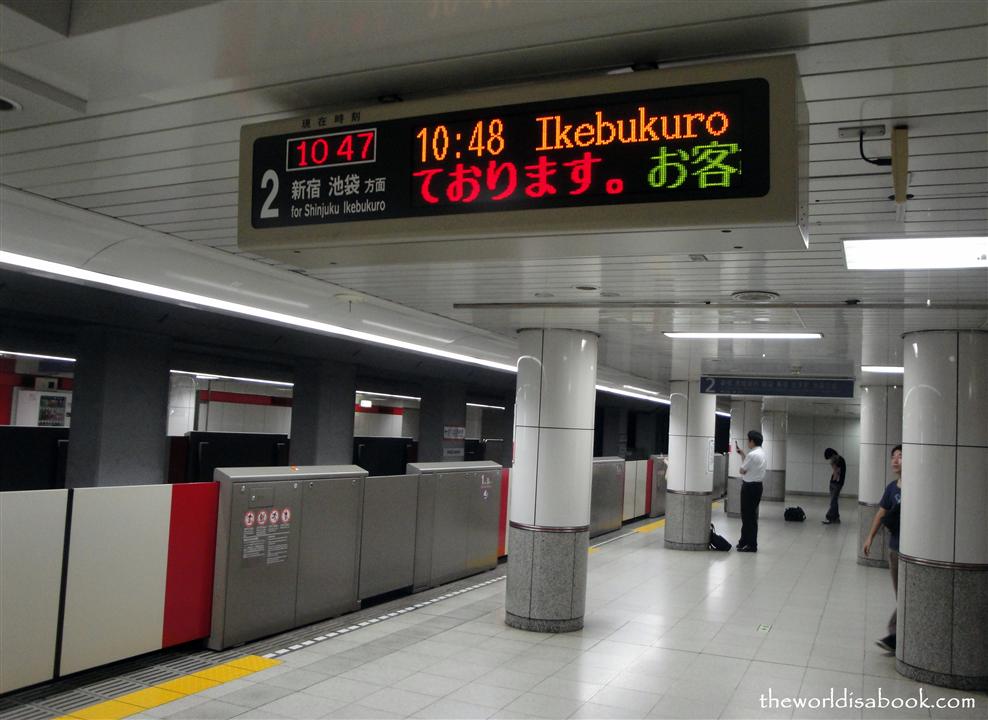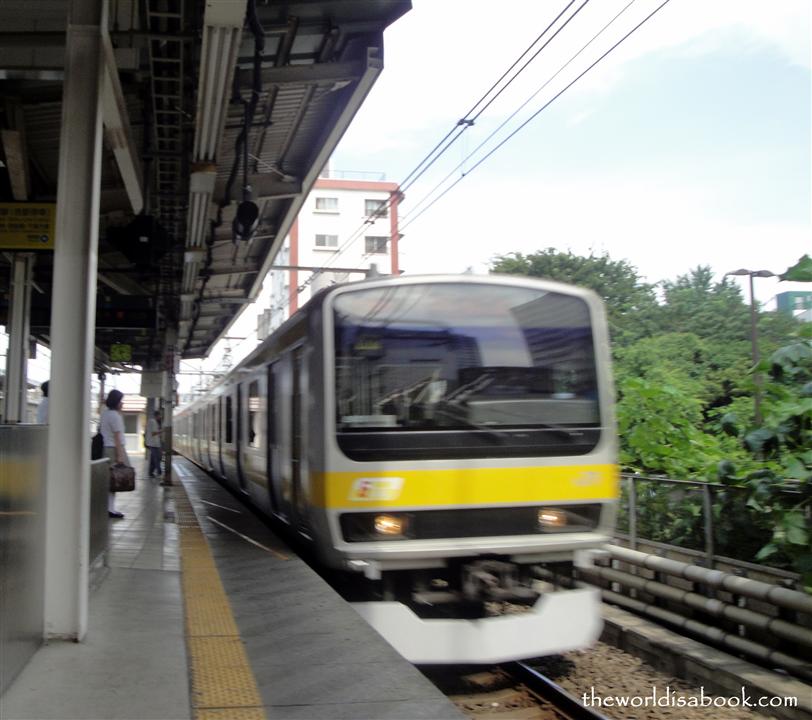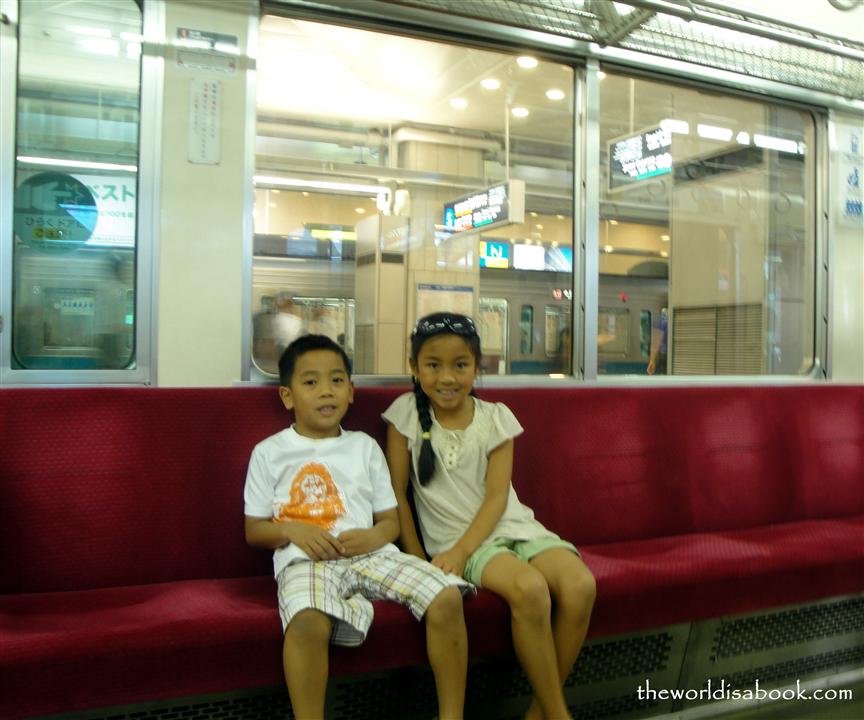We left for Tokyo the Friday before 4th of July weekend. The plane was pretty full but mostly occupied by the Japanese. From what we saw during boarding, there were less than 10 non-Asians on the flight we had. It was an uneventful and long 11 hour flight. Our kids fell asleep for most of the flight since we left LAX at 1AM.
The flight attendants gave them food when they woke up almost towards the end of the flight. International flights are awesome for the kids with the vast choices of in-flight entertainment. We did miss the extras they got from Air France of a little kit of toothbrushes and toys. They got Delta wings before we left which was better than nothing. Our meals were mediocre but nowadays, I was glad I actually got a meal and with this flight – a dinner and breakfast.
We got in to Haneda Airport around 5 AM and looked at the window and the sun was out. I had to doublecheck the local time and later found out sunrise was at 5AM and sunset was at 7PM. There were barely any lines once we got to immigration and we waited less than 5 minutes. We had to do the a fingerprint scan with the exception of the kids.
The baggage carousel was right outside immigration and we spotted our luggage as we got there. The fastest turn around for lugagge pickup EVER. We’ve come in to other airports during the wee hours of the morning and this was still super fast and efficient. They seriously need to send our baggage handlers and Immigration officers for a week of training in Japan.
Getting From Haneda Airport to Tokyo
We walked out of baggage claim and found a couple of ATMs to get money. We felt almost rich to be holding a 10,000 Yen bill (about $125). We got some maps from a tourist information desk where they spoke English very well and saw the signs for the Keikyu train to Tokyo. We bought our tickets which cost 530 yen (about $6.50) to Shinjuku. Times were posted for the next train to arrive so we rushed down to the platform.
The trains were clean and modern with a lot of ads in the cars. We had the train cab to ourselves along with four other American tourists. We took the train to Shinagawa and transferred to a JR train bound for Shinjuku station which was near our hotel.
The walk between the two trains wasn’t that bad and there were clear signs in English to follow. We were surprised at the number of people dressed for work and kids going to school on a Saturday at around 7 AM. We later found out that the kids go to school every 1st and 3rd Saturday of the month in Tokyo.
Getting Around Tokyo
Tokyo’s train and subways are extensive and that is an understatement. Unlike most other major cities in the world where there was usually one way to get to the tourist spots via public transportation, there were various ways to get to one spot in Tokyo. They had the Japan Rail trains and 2 subway networks with 13 lines.
We didn’t go on any tour bus and traveled all over Tokyo and to two nearby trip cities by trains and subways. Seeing the maps for the first time was scary and overwhelming and a cause to almost freak out.
This was the subway map I first saw and this was the train map. Very intimidating! Overall, their trains and subways were timely, well organized and so efficient and by Day 2, we got the hang of it.
Tokyo Public Transportation Apps
We planned most of our itinerary and determined the nearest subway or train station and figured out the fastest and/or cheapest routes to get there. Our best navigation tool was using our iPhones and downloading the metrO app which were free and did not need Internet connection.
The no network connectivity was great since we took our SIM cards off our phone and free wireless connections were not widely available. We never had to carry the subway map or look at the scary diagram. These apps were such lifesavers in navigating the Tokyo transportation system.
Metro gave us the number of stops and changes, direction to take, detailed train routes and the travel time. You can take the shortest route or the one with the fewest changes route. With kids in tow, we usually took the routes with the fewest changes to minimize transfers and walking from one platform to another.
It was even color coded matching the color lines of the trains. The detailed route also indicated what the next station stop was supposed to be to ensure you were going the right direction. It was such an invaluable tool. They have it for many cities in the world too.

Hyperdia was also a very great site when planning routes but we never got it to work on our phones. It was a valuable tool to use online to plan stops and itineraries.
Tokyo Public Transportations Costs
What surprised us though was how much pricier the train and subway tickets were compared to other cities we’ve visited recently (i.e. Paris, Madrid, Rome). The cheapest subway ticket which could be one stop was 160 yen which was about $2. Kids 5 and under were free while 6-11 years old were half price on all train and metro rides. We didn’t do the day passes since we planned our itinerary to go to one particular area.
The ticket machines had English and the overhead train maps were not always clear how much it would cost. When in doubt, get the cheapest fare and when you get to your destination do an adjustment on one of the machines or with the staff. Most of them didn’t speak English but we just handed them our tickets and they showed us on the calculator how much we owed them.

We got to know the circular JR Yamanote line pretty well since this was where most of the tourist attractions were located and looped around central Tokyo. You cannot use the JR tickets on subways or vice-versa. We made that mistake once when we exited the JR line to the subway line thinking we could transfer. We had prepaid all the way to our destination and had to pay again for a subway fare. We totally missed that part during our research since we had mainly ridden the JR trains.

Riding Tokyo Subway Train
The trains and subways were very clean. There were announcements in Japanese and English that told us what the next stop was and which side of the door we would be exiting which was pretty convenient. In most of the train rides, no one talked and some talked in low voices. Many were busy reading, napping or playing with their phones.
Every time I saw the “sleepers”, I was secretly hoping to see one wake up in a state of panic and try to figure out where they were. It never happened so I guess they have some sort of secret alarm once they get close to their destination. We never saw any rude people talking on the phones for everyone to hear. It was such a blessing of courtesy.
Some of the escalators going down were not working since the whole country was still conserving energy but it wasn’t that bad. There were markers to line up to enter the train and people actually followed them.
The space between the platform and the trains in some stations was pretty wide and wide enough for a child’s foot or leg to slip or a shoe to fall through. I wish I had taken a picture so be careful when travelling with children.
Yes, it got pretty crowded at certain times but we managed and it never got to the point of being too close for comfort with complete strangers. We really wanted to see the white-gloved attendants called oshiya or pushers try to shove people into the trains and subways during rush hours. We didn’t get the chance since we avoided rush hours for the most part. So, here’s what we would have seen. It’s no wonder there are so many of these videos on You Tube and would have been a sight to see.
Related Posts:



Wow, this is really helpful! We are taking 2 kids to Japan soon too. Thank you.
Thanks for stopping by and I hope you have a great trip to Japan.
We are in Tokyo with our two kids 6 and 8 and are having a great time. I don’t know how I found your blog but we have found the metro apps that you mentioned to be invaluable. Thanks for taking the time to post